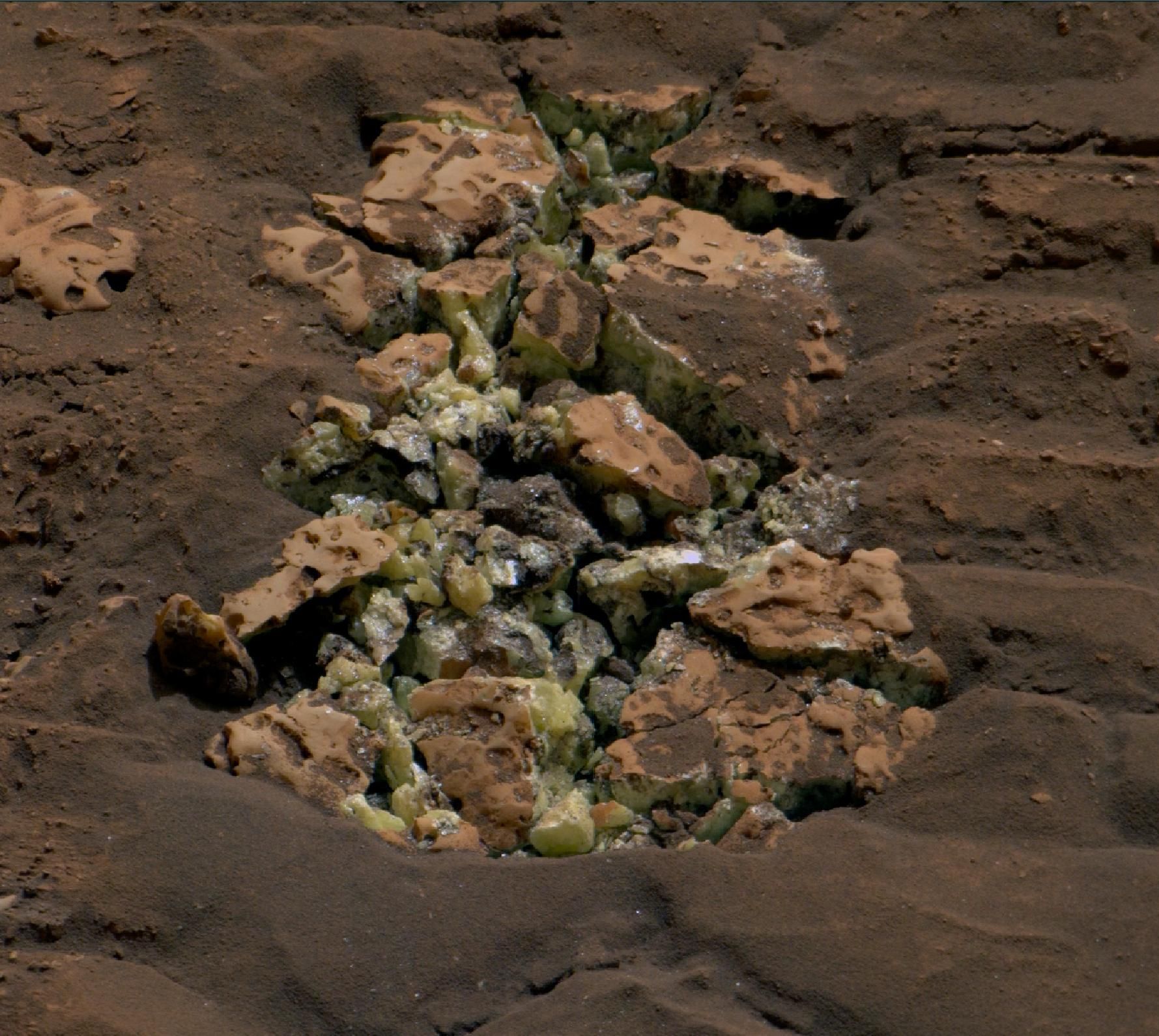Scientists are constantly searching for any signs of life on Mars, and though there have been many discoveries over the years, one made on accident by the Curiosity rover within the past year just might be the last clue we needed to reinforce just how likely it is that Mars may have supported life at some point.
The Curiosity Rover’s Accidental Discovery
While the Curiosity Rover is often looking for specific things up on Mars to supplement our current knowledge of the planet, that doesn’t mean it can’t accidentally discover something incredible. Some months ago, while Curiosity was traversing the Red Planet, it accidentally drove over a rock and cracked it open. Within that rock was something that had never been seen on Mars prior to that point: yellow sulfur crystals.
This may not sound too incredible on its own, but NASA scientists were astounded by the discovery and what it represents. Stones made of pure sulfur should, theoretically, not exist on the surface of Mars based on our previous understanding of the planet’s environment and how it existed in the past. It’s like finding seashells in a desert for the first time—it reshapes your entire understanding of what that desert was like in the past.
This is why the discovery of these odorless crystals is such a big deal.
What Does it Mean for Yellow Sulfur to be on Mars?
So, Curiosity found some bright, odorless sulfur crystals in a rock. What does that mean? Well, naturally, we don’t know exactly what it means right away, but we do know what it may point to. Right now, scientists are primarily concerned with how these crystals were formed, and how they can exist alongside other types of deposits on Mars that indicate a more water-filled past.
Now, Mars has always had sulfate-rich regions. In fact, Curiosity has been exploring those regions since 2023. There are different types of sulfates, but the ones we’ve found on Mars are formed when water evaporates and mineral salts are left behind. Before now, they were only ever detected as constituents of sulfur-based minerals. The sulfur that Curiosity recently discovered in that rock is pure elemental sulfur, which is a first on Mars.
Elemental sulfur is very different from the hydrogen sulfide variety. You can get all the specifics here, but for now, just know that elemental sulfur is odorless and requires extremely specific circumstances to form. Those circumstances were never before associated with Mars, which means scientists need to reevaluate their understanding of Mars’ past. It’d be like finding the remnants of a tree in a location where trees have never been seen before. That completely changes our understanding of the location’s history.
Furthermore, the presence of this elemental sulfur could serve as a new indicator of life on Mars as well.
What Does Sulfur Have to Do With Alien Life?
Sulfur does not necessarily mean that there is or was guaranteed alien life on Mars. Our hunt for alien life is still in progress. However, it does have some implications for the potential of life on Mars. There are many microorganisms on Earth that use sulfur compounds as an energy source. Sulfur compounds found on Mars, even before this most recent discovery, always raised some questions about ancient Martian habitats, and we’ve known for some time that Mars was once a watery planet.
After all, water impacts the way sulfates form, so the sulfates we have already discovered proved that Mars once had water. Water has been determined as a critical ingredient for all forms of biology that humanity understands. However, pure sulfur indicates some unique conditions that may expand the possibilities for what microbial life may have looked like in the Red Planet’s past, not to mention provide more info about the hydrothermal systems on Mars and what ancient habitats may have existed before.
Specifically, pure sulfur is a critical component of life as we know it, playing a major role in protein synthesis. It’s also known to be produced in chemical reactions in extreme Earth environments like hydrothermal vents in the deep ocean. So the presence of elemental sulfur on Mars not only expands the list of potential habitats the planet may have supported in the past, but also increases the likelihood that the planet once supported life.
Needless to say, a whole new realm of theoretical possibilities has opened up. While it’s still impossible to say if life ever existed on Mars for certain, the discovery of elemental sulfur does make it even more likely than it was before. In order to continue learning more, Curiosity has been drilling dozens of holes in Mars’ sulfur fields, digging up new samples to further reveal the chemical history of the Red Planet.
Ultimately, the search for alien life continues regardless of this discovery. We still can’t say with certainty if there is alien life out there, or if any alien life ever existed in the cosmos at all, on Mars or otherwise. But with each new discovery we make, our understanding of the universe grows, and it seems more and more likely that, at some point at least, there were lifeforms out there beyond the Earth. If nothing else, we’ve learned even more about Mars.






